Standard [CURRENT]
ASTM F 3143:2020
Standard Test Method for Determination of Frictional Torque and Friction Factor for Hip Replacement Bearings under Standard Conditions Using a Reciprocal Friction Simulator
- Publication date
- 2020
- Original language
- English
- Pages
- 9
- Publication date
- 2020
- Original language
- English
- Pages
- 9
- DOI
- https://dx.doi.org/10.1520/F3143-20
Product information on this site:
Quick delivery via download or delivery service
Buy securely with a credit card or pay upon receipt of invoice
All transactions are encrypted
Short description
1.1 This test procedure provides a method of determining the frictional torque and friction factor of artificial hip joint bearings used in total hip replacement (THR) systems under laboratory conditions using a reciprocal friction simulator. This test method specifies the angular movement between the articulating components, the pattern of applied force, and the way data can be measured and analyzed. 1.2 Many variables can be investigated using this test method including, but not limited to, the effect of head size, different inclination/version angles, different deformation levels of the acetabular cup, bearing clearances, lubrication, scratched heads, and artificial ageing. 1.3 The values stated in SI units are to be regarded as standard. No other units of measurement are included in this standard. 1.4 This standard does not purport to address all of the safety concerns, if any, associated with its use. It is the responsibility of the user of this standard to establish appropriate safety, health, and environmental practices and determine the applicability of regulatory limitations prior to use. 1.5 This international standard was developed in accordance with internationally recognized principles on standardization established in the Decision on Principles for the Development of International Standards, Guides and Recommendations issued by the World Trade Organization Technical Barriers to Trade (TBT) Committee.
ICS
11.040.40
DOI
https://dx.doi.org/10.1520/F3143-20
Also available in
Loading recommended items...
Loading recommended items...
Loading recommended items...
Loading recommended items...

